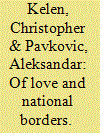|
|
|
Sort Order |
|
|
|
Items / Page
|
|
|
|
|
|
|
| Srl | Item |
| 1 |
ID:
111862


|
|
|
|
|
| Publication |
2012.
|
| Summary/Abstract |
Croatia became a UN member only in 1992, after the violent break-up of Yugoslavia. Its anthem is marked by historically founded ambivalences as to the nature and territorial extent of the nation in question. This article offers an interpretation of the current version of the anthem and an analysis of the narrative and imagery of the nineteenth-century poem from which the anthem originates. Three of the anthem's four stanzas speak about the Croats' love for their homeland and their people and of the steadfastness and immortality of their love; the remaining stanza extolls the beauty of the homeland. By addressing the homeland's rivers and the sea directly, its singers appropriate this geography and so demarcate the borders of their much-loved homeland. The anthem thus asserts Croatia's unity (against potential pretenders) and its unbreakable ties with its people. In contrast, the original fourteen-stanza poem 'The Croatian Homeland', written in 1835, is a paean to the Croats' ties to nature, their simple life and bravery - the romantic virtues of pure national souls. On their path to anthemhood, the four stanzas drawn from this poem have undergone significant modifications and additions, the result being a song that is doubly reassuring: it reassures the singers first of the people's love for themselves as a people, and second that this love is the means by which the 'natural' territory of the homeland is maintained.
|
|
|
|
|
|
|
|
|
|
|
|
|
|
|
|
| 2 |
ID:
098147


|
|
|
|
|
| Publication |
2010.
|
| Summary/Abstract |
This paper presents a comparative study of two key contenders for Serbian anthem-hood, the royalist song 'God of Justice' and the pan-Slavic hymn, 'Hey Slavs'. Drawing on the theorising of nation and representation, as developed by Benedict Anderson, Michael Billig and others, the purpose of the study is to compare the self-images these songs present to those they enjoin in unison, and to consider the role of those images and the identities they suggest in national/ist ideologies. Neither of the songs discussed in this paper was originally intended to be a national song. Both are in this sense 'accidental anthems'. The paper will discuss the history of the accidents which have at various times given, and deprived, these songs of anthem status, in Serbia. 'God of Justice', originally a song in a patriotic stage play of the 1870s (commissioned to legitimise a young prince's accession to the Serbian throne), was the national song and later the official national anthem of the Principality of (later Kingdom of) Serbia from 1872 to 1919 and then, in a changed form, part of the national anthem of the Kingdom of Yugoslavia from 1919 till 1941. It was resurrected in 2006, in a changed - republican - form to become the national anthem of the Republic of Serbia. The pan-Slavic 'Hey Slavs', written in 1842, emerged, a century later, first as a national song of the Communist-led resistance movement in Yugoslavia in 1942 and then became an unofficial national anthem of the Communist-ruled Yugoslav federation; it survived the violent disintegration of that federation in 1991 to serve (once again unofficially) as an anthem of the rump Yugoslavia from 1992 to 2006. Why have these particular songs been chosen for the purpose of representing the Serbian nation to itself and to the world? How has each succeeded and failed in that task? The essay concludes with some speculation on these questions.
|
|
|
|
|
|
|
|
|
|
|
|
|
|
|
|
|
|
|
|
|